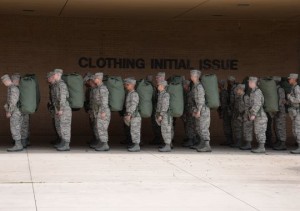Ask questions in the Newbie Thread at /r/airforcerecruits
On one of your first few days at basic training you will march in your civilian clothes to a large building where you will receive your initial military clothing issue. This process will take most of the day, and will involve a lot of standing around waiting, much like everything else in BMT.
Some point early in this process you will go into a room and strip down to your underwear, then step into a machine one at a time to be measured for your clothes. You’ll strike a silly looking pose in this machine and a group of lasers will go up and down you body, scanning and taking measurements. You’ll then be given your PT gear to put on, which will consist of shorts and t-shirt, and sweat pants and shirt in the colder months. The inside of the sweats are fuzzy, and with the guys all having newly shaved, prickly heads, all that fuzz will come off on your head and the rest of your body, which will look quite silly.
You’ll also be issued your ABU or Airman Battle Uniform, which is the normal tiger stripe digital camouflage that you see Air Force personnel wearing. This will include t-shirts, your tops and pants, belt, boots, socks, cold weather gear, etc.
The way all of this gear is handed out to you is very specific. There will be AF personnel there telling you how to do it step-by-step, so just pay attention and do what you’re told. You’ll have to line up in certain places, fill out certain forms, get the correct number of items, etc.
You’ll wear your PT gear back to the dormitory, carrying all of your new gear on your back in your duffel bag. It’s a lot of gear, and it can be challenging just getting it all into your bag, let alone carrying it the considerable distance back to your dormitory. If you have the pleasure of going to basic in the summer months, it will an especially tiring and sweaty trip back home.
Your TI will eventually tell you how to wear the uniform in little classes in your dormitory’s day room. You’ll spend hours cutting the strings off of the uniforms and making sure everything is perfect looking. Luckily for new recruits, you don’t have to polish the green boots as they are suede instead of black leather like the previous BDU uniforms, so you will not have to spend hours in the dormitory polishing your boots.
Weeks later in the training process you will return to the same building and be issued all of your blues. The term blues obviously refers to your blue dress uniform which includes leather shoes, slacks, belt, silver belt buckle, long and short sleeve shirts, ties, dress coat, overcoat, and your pointy blue hat. This process can take even longer than your initial clothing issue, because all of your clothes are fitted and adjusted on the spot. You’ll be measured while you are there by the staff and they’ll send your measurements off to another room where the length of your pants, suit coat, skirt, etc will all be adjusted on the spot and given back to you in a couple of hours. When the day is over you’ll have a perfectly fitted set of uniforms to wear. Again you’ll spend hours cutting strings and ironing out wrinkles in your dormitory, but you won’t actually wear your blues until your graduation week of training when you become the senior flight. It’s a great feeling to wear your blues, as every other trainee on base knows that you are the senior flight and are about to graduate. It also means you are about to graduate and get the hell out of basic training, which is the best feeling of all.

